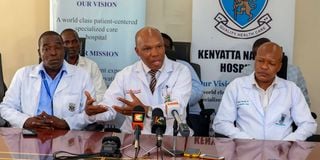KNH performs 15-hour operation to separate Bungoma conjoined twins

Kenyatta National Hospital Chief Executive Officer Dr Evanson Kamuri (left), Consultant neurosurgeon Dr Kiboi Julius Githinji (Centre) and the hospital’s Director of Surgical Services Dr Kennedy Ondede address journalists after successful separation of conjoined twins at the facility on February 6..
For 15 hours, doctors at the Kenyatta National Hospital (KNH) performed a complicated surgery that has seen a pair of male conjoined twins born four months ago in Bungoma County separated.
It took about 38 medical experts from the KNH and the University of Nairobi to perform the highly complex medical procedure.
The team consisted of plastic and reconstructive surgeons, paediatric surgeons, anaesthetists, cardiothoracic specialists and six nursing officers.
Dr Joel Lessan, paediatric surgeon from the University of Nairobi who led the team said the surgery was done as an intervention to save the babies who were already on observation since late last year.
Earlier, the specialists had agreed that the children would have been separated at six months, but they had to shorten the wait to save their lives.
Also Read: Baby born with two heads and three arms
“Normally, we have to wait until they mature for doctors to conduct the surgery, but one of the twins developed complications like cardiac arrest, the other even got Covid-19 at some point so we had to act fast,” he said.
“By mid-January, we also started noticing that the blood pressure of one of the kids had started to go up despite the medication we gave the child, we were not able to bring it down
The twins were joined at the chest and abdomen.
The first surgery, which happened in mid-January, took about eight hours and while at the Intensive Care Unit post-operation, the children did well only on the first day and got an infection that needed urgent attention.
The surgery involved developing flaps to cover the separation lines and the doctors were to wait for another eight weeks before completing the surgery. However, the infection changed the timeline.
The doctors, therefore, made an emergency decision to separate the twins on Saturday evening at 10pm.
“If a child has a lot of blood flowing to their lungs, they are susceptible to getting an infection. One of the children was affected, he also got a cardiac arrest but luckily, he was resuscitated. It is then that we put up our team to separate them,” said Dr Lessan.
After the hour-long anaesthesia for the two kids, the first separation had to be done in the abdomen. The twins shared one liver and the doctors had to carefully separate them to ensure each child gets just enough to sustain their body. It took about three and a half hours.
“For us to achieve this separation of the liver, it needed advanced technology and technique which we had at the hospital. From the imaging we had done in the X-ray department, we knew what to expect and what portion of the liver each child needed,” said Dr Lessan.
The chest separation, which was the next assignment, took about an hour. The chest had skin, muscles and bones that needed to be set apart.
“Delicately, and with precision, we had to achieve that to ensure that each child has their heart in their own chamber,” said Dr Lessan.
At 8 o’clock on Sunday, the twins were now separated, the doctors too, dealt with them separately sealing open areas in the skin that came about during the surgery.
“It was amazing to see one set of the conjoined twins turn into separate children. We are dedicated to ensuring that their follow-up care nurtures them into happy and healthy children,” said KNH’s chief executive Dr Evanson Kamuri.
Dr Julius Kiboi of the University of Nairobi said that a multidisciplinary approach in conducting such complex surgeries is the way forward and will improve Healthcare in the country.
The twins are now in the Intensive Care Unit, but the doctors are not sure when they will stabilize.
The hospital has another pair of conjoined twins whose fate of separation is still pending the clinicians’ approval.





